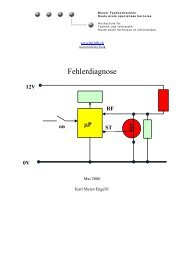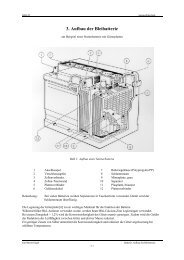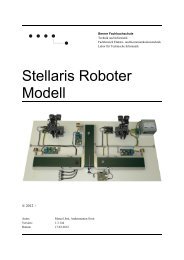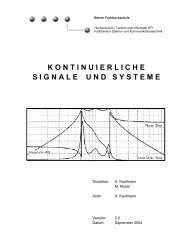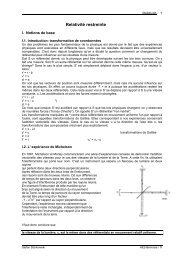start-/stop-system and the battery - Berner Fachhochschule
start-/stop-system and the battery - Berner Fachhochschule
start-/stop-system and the battery - Berner Fachhochschule
Create successful ePaper yourself
Turn your PDF publications into a flip-book with our unique Google optimized e-Paper software.
The advantages of lead-acid batteries are:<br />
low cost<br />
low internal resistance<br />
recyclability<br />
safety<br />
The aging mechanisms of lead acid batteries are (1):<br />
anodic corrosion of grids<br />
positive active mass degradation <strong>and</strong> loss of adherence to <strong>the</strong> grid<br />
irreversible formation of lead sulfate in <strong>the</strong> active mass<br />
short-circuits<br />
loss of water<br />
acid stratification<br />
In <strong>the</strong> past, most batteries failed by grid corrosion.<br />
Starting required only a very small fraction of <strong>the</strong> <strong>battery</strong> capacity. Most of <strong>the</strong> time <strong>the</strong> <strong>battery</strong><br />
remained almost completely charged. When <strong>the</strong> engine was running, <strong>the</strong> <strong>battery</strong> was charged by <strong>the</strong><br />
alternator, which resulted in permanent overcharge.<br />
When using <strong>start</strong>-/<strong>stop</strong>-<strong>system</strong>s, <strong>the</strong> batteries will be subjected to shallow cycling.<br />
This means, that during a <strong>stop</strong>, <strong>the</strong> <strong>battery</strong> must deliver <strong>the</strong> electric energy for <strong>the</strong> vehicle.<br />
In <strong>the</strong> present paper "shallow cycling" means cycling to a depth of discharge of about 5 to 20 %, at a<br />
discharge rate of about 1C.<br />
Starting an internal combustion engine means very high currents for a very short time. Therefore, a<br />
low internal resistance is a must.<br />
Unfortunately, <strong>the</strong> service life of <strong>the</strong> conventional SLI batteries, under shallow cycling conditions, is<br />
reduced. The reason is acid stratification.<br />
When batteries are subjected to a large number of cycles, one observes active mass degradation <strong>and</strong><br />
loss of adherence to <strong>the</strong> grid [3]. Mechanical compression on <strong>the</strong> sidewalls of <strong>the</strong> <strong>battery</strong>, will reduce<br />
<strong>the</strong>se processes.<br />
We already knew from tests in <strong>the</strong> past, that mechanical pressure is a simple <strong>and</strong> efficient means to<br />
increase <strong>the</strong> cycle life. As shown in this paper, this is not always <strong>the</strong> case under shallow cycling<br />
conditions.<br />
Failure detector<br />
Regarding <strong>start</strong>-/<strong>stop</strong> <strong>system</strong>s, it would be useful for <strong>the</strong> driver to know, if <strong>the</strong> <strong>battery</strong> is capable to<br />
provide <strong>the</strong> necessary energy for <strong>the</strong> next <strong>start</strong>ing operation. Modern automobiles should be equipped<br />
with an onboard diagnostic <strong>system</strong>, indicating any <strong>battery</strong> failure.<br />
From many <strong>battery</strong> tests we learned that normally one single cell is responsible for <strong>battery</strong> failure. One<br />
defect cell can cause problems with engine <strong>start</strong>.<br />
For a failure diagnosis one simple means is, to measure separately <strong>the</strong> voltages of <strong>the</strong> two <strong>battery</strong><br />
half’s. A difference of 2V ore more between this voltages indicates, that <strong>the</strong>re is a defect <strong>battery</strong> cell.<br />
We used a microprocessor to measure <strong>and</strong> compare <strong>the</strong>se voltages. This allowed to measure <strong>the</strong><br />
voltage difference also during very short discharge pulses.<br />
The idea described above was already patented in 1983 [5].<br />
Today, small <strong>and</strong> cheap microprocessors are available.<br />
However, measurements of half-<strong>battery</strong> voltages require a center-tap, which results in additional<br />
costs.<br />
For 24V or 36V electrical <strong>system</strong>s, <strong>the</strong> described failure detector can be easily installed at <strong>the</strong><br />
connection between <strong>the</strong> 12V blocs.



